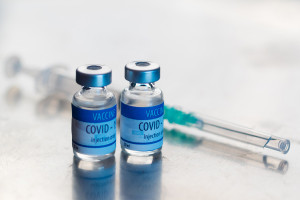5 Questions About Johnson & Johnson’s COVID-19 Vaccine Candidate, Answered
From how it differs from the Moderna and Pfizer vaccines to when it could be available for use, CHOP vaccine expert Paul Offit helps us break it down.

Wondering how the Johnson & Johnson vaccine candidate for COVID-19 compares with the alternatives? Here’s what you need to know. Photograph by Getty Images/MarsBars
Over the weekend, Johnson & Johnson announced promising results from the third and final phase of clinical trials for its single-shot COVID-19 vaccine candidate. The company says the vaccine, developed at its Janssen pharmaceutical unit, is 66 percent effective overall in preventing “moderate to severe” COVID-19 cases four weeks after vaccination and 85 percent effective in protecting against “severe” cases — and that it provides “complete protection against COVID-related hospitalization and death.” (Notably, it was less effective in South Africa, where a newer, more contagious variant is spreading.) These findings are based on nearly 44,000 volunteer participants from different geographic regions and age groups and with various health conditions, with considerations for emerging coronavirus variants.
In light of the recent data, Johnson & Johnson plans to file for emergency use authorization (EUA) from the FDA as early as this week. Because this candidate might become a viable vaccination option in the very near future, we chatted with Paul Offit, director of the Vaccine Education Center at CHOP and member of the FDA’s advisory committee for vaccine approval, to break down the most important information we should know about the candidate now.
How does Johnson & Johnson’s vaccine candidate work?
Normally when you make a vaccine, you take a virus, grow it in the lab, and inactivate it. Offit says that’s how hepatitis A and rabies viruses are made. You can also weaken the virus, as with the measles and chicken pox vaccines (called attenuated vaccines), or inject the virus’s spike protein, which is how hepatitis B and HPV vaccines work.
Offit says the Johnson & Johnson COVID-19 vaccine candidate instead utilizes a version of an adenovirus, the kind of virus that causes mild cold or flu symptoms. In the vaccine, the adenovirus is non-replicating, meaning the genetic material entering the body can’t reproduce or multiply. In the case of Johnson & Johnson’s vaccine candidate, the virus enters the nucleus of the cell and instructs the cell how to make the spike protein needed to protect your system against the disease. Your body’s cells literally remember how to fight the virus if or when they encounter the virus again in the future, providing immunity.
Moderna’s and Pfizer’s vaccines require two shots, but Johnson & Johnson’s current candidate only requires one. Why is that?
As reported by Janssen, researchers in its third-phase trials tracked illness 28 days after vaccination, which is around the time when participants would have received a second dose from a two-dose shot. According to the report, the vaccine provided protection against 85 percent of “severe” cases and complete protection against COVID-related hospitalization and death.
Paul Stoffels, Johnson & Johnson’s vice chairman of the executive committee and chief scientific officer, says, “A one-shot vaccine is considered by the World Health Organization to be the best option in pandemic settings, enhancing access, distribution and compliance. Eighty-five percent efficacy in preventing severe COVID-19 disease and prevention of COVID-19-related medical interventions will potentially protect hundreds of millions of people from serious and fatal outcomes of COVID-19.”
Aren’t two shots better than one, though?
Not necessarily, Offit says. Sure, the efficacies among the vaccines differ — Moderna’s and Pfizer’s are slightly more effective at preventing symptomatic infections — but the overall goal is to keep you out of the intensive care unit and, and more importantly, out of the morgue. The Johnson & Johnson candidate has been shown to do that in its clinical trials. Plus, distributing single-dose shots is much easier than distributing multiple doses.
It’s important to note that Johnson & Johnson is currently investigating a double dose, and we should know more about that candidate’s efficacy in a few months. Also, a Johnson & Johnson rep says its shot may have demonstrated a lower level of efficacy because it was tested at a time when higher levels of the virus were circulating.
Why doesn’t this vaccine need to be transported and stored at super-cold temperatures?
Offit says that’s because its chemical characteristics don’t require it. Remember, Johnson & Johnson’s candidate uses an adenovirus, unlike Moderna’s and Pfizer’s mRNA vaccines. Pfizer’s needs to stay on dry ice or in a super-cold freezer and has a refrigeration life of about five days, while Moderna’s can last about six months stored at freezer temperatures or about 30 days in a refrigerator. Both of those vaccines can only live for six hours or so once the vials are punctured. But because Johnson & Johnson’s candidate has a different chemical makeup from the other vaccines, it can be stored at refrigerator temperatures — 35 to 46 degrees Fahrenheit — and remain stable for at least three months. (It lasts up to two years when stored at -4 degrees Fahrenheit.) This is beneficial for obvious reasons, but especially for regions that don’t have access to super-cold storage.
When might it be approved for distribution and use?
Once Johnson & Johnson applies for EUA, the FDA will look at the data of every single person who went through its trials to make sure there are no discrepancies, explains Offit. Johnson & Johnson will then set a date with the FDA advisory committee to recommend the candidate move to the next stage. If and when the FDA permits use, the CDC will publish recommendations for use for specific groups. This essentially enables Johnson & Johnson to begin distribution in the United States. Given the quick timelines for previous COVID vaccines, Johnson & Johnson’s candidate could be approved sooner rather than later.


